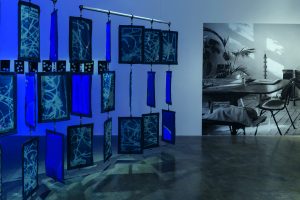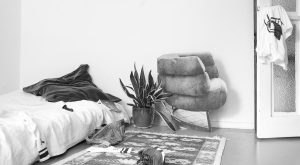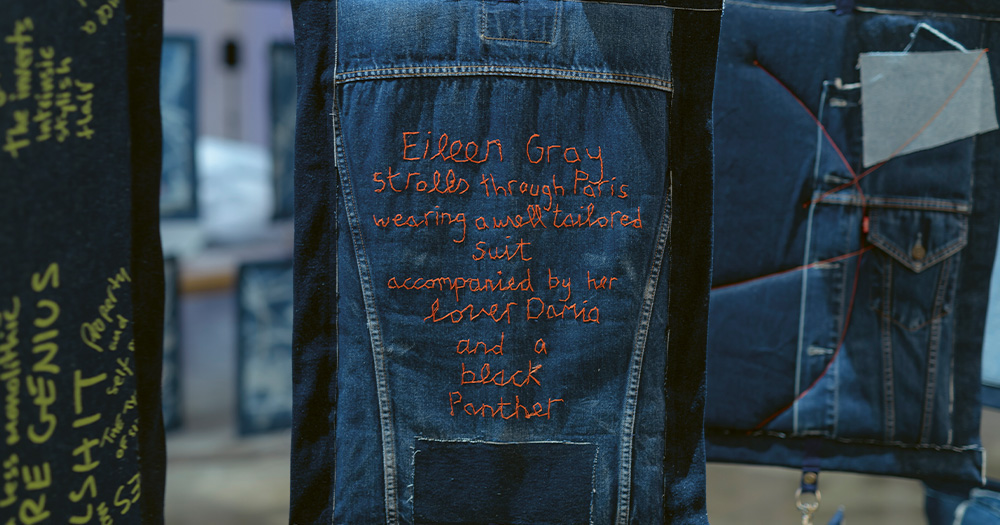Too often, there is a tendency to read history through a contemporary lens; to project a modern, heteronormative understanding of identity and sexuality upon the people whose lives we are revisiting. However, when we allow ourselves to step outside these conventions and imagine a more abundant interpretation of sexuality, greater possibilities emerge. The latest exhibition by visual artist Emma Wolf Haugh, Domestic Optimism at Project Arts Centre, does just that.
The exhibition reflects on the life and work of Irish-born architect and designer Eileen Gray. However, in contrast to the popular narratives surrounding Gray, Emma Wolf Haugh delves into the absences within these narratives to reimagine a more expansive interpretation of the myths shrouding Gray’s legacy.
Domestic Optimism is told in two acts; Act One: Modernism – A Lesbian Love Story and Act Two: Radclyffe Hall – The Lazerbeam Theirstory Projects. Each act undertakes to tell a different aspect of Gray’s story and the influences she brought to bear on her surroundings.
The core of the exhibition is framed by Act One. It serves to explore the impact of Gray’s sexuality upon her life and work. Through the application of queer strategies, Wolf-Haugh reflects on Gray’s Anglo-Irish upbringing, the deconstruction of her first architectural venture, E 1027, by Le Corbuisier and relationships with her lesbian peers. As the exhibition text suggests, “(by) employing queer strategies, this promotes an understanding of the critical shifts around femininity, behaviours revolving around power, the unhinging of gender from biological sex, and the parameters of sexual transgression, desire and identity across interactions of political, social, legal, and aesthetic realms.”

Act Two takes on a queer working-class feminist exploration into the Ballymun flats. Developed in the ‘60s in response to the social housing crisis, the complex was modelled on LeCorbusier’s concept of the ‘Radiant City’. The work is presented in the form of a zine that imagines one of the tower blocks as a queer utopian space occupied by working-class queer squatters. The zine intersects the narrative of Act One and further employs documents pertaining to the Radcliffe Hall obscenity trials paired with material from the development of the Ballymun project.
Upon entering the gallery immediately the viewer is struck by a series of suspended screens. The screens consist of 15 panels of erratically bleached denim. Each panel is uniquely designed. Occasionally the denim is backed by a turquoise material reminiscent of shell suits from the 1990s, others are emblazoned with gold graffitied text with slogans such as, “No More Genius Bullshit”. Many are adorned with clusters of badges with black and white photographs of lesbian women from the 1920’s and ‘30s or images of modernist buildings and furniture and their respective blueprints.
Most are embroidered with a red thread looping connections through the patterns or highlighting the protest text or linking the narratives between the clusters of badges. On one particular panel, the embroidery becomes more elaborate, adorning the back of what appears to be a jacket with the words, “Eileen Gray strolls through Paris wearing a well tailored suit accompanied by her lover Damia and a black panther”.
The screens serve to partition the gallery, guiding viewers towards the far corner, to a recreated living space. The walls display two near-lifesized black and white photographs of living spaces with cushions strewn on the floor. To the right of the gallery are five life size cardboard cutouts of colonial military furniture. Each piece of furniture is set alight by cardboard orange and red flames, contrasting against the black and white images.

The opposite side of the gallery is dedicated to the projection of the exhibition’s key component, the Domestic Optimism film. As the introductory title credits finish – think uber-camp Rocky Horror-style red dripping text against a Priscilla Queen of the Desert-style tinsel background – the film opens with the words, “Campaign Chair”. Followed by a shot of one of the aforementioned cardboard cut-out chairs (albeit shrunk to hand-size).
The chair sits front of stage, surrounded by other cutouts of campaign furniture to one side and black and white photographs of women, backed with the same flame motif as the exhibition furniture. Behind them are the blurred denim screens and shimmering tinsel. A computerised Scottish female voice welcomes the viewer and invites them to “take a seat” and immediately segues into considering the colonial provenance of the on-screen chair.
As the welcoming speech concludes, a synthesised drum rhythm begins. The film cuts to the ‘narrator’ standing by a microphone stand. Behind them hangs one of the denim panel screens with a tinsel curtain backdrop. They are wearing a matching denim baseball cap and boiler suit with the same erratic bleach pattern as the screens. The outfit is accessorised with a pair of reflective aviator sunglasses, as if to disguise their identity. They begin lip synching to a computerised British male voice.
From here on, the film alternates between the narrator, performing exaggerated gesticulations to an exaggerated Dublin accented voiceover and the set of the cutouts. As the narrative unfolds, a hand moves the cutouts around the set accordingly, by way of animating the story.

The film runs for 38 minutes as the tongue-in-cheek narration intricately and seamlessly weaves together the various elements of the project. It plays out in three parts. As already illustrated, the first part, Campaign Chair, suggests the foundations of Gray’s furniture design inspiration and its problematic colonial past. In the second part, Faggoty Tour Guide Presents E 1027, we learn of the Swiss architect Le Corbusier (or Corbu as the narrator more fondly refers to him); his obsession with Gray’s modernist house E 1027; his sapphic desires; and his fascist practices. Butch Tour Guide Presents Gertrude Steins Portrait Chair, forms the third and final part.
It effectively blurs the boundaries between reality and fiction in recounting how, a 1927 soiree celebrating feminist writer Gertrude Stein, becomes a debaucherous lesbian orgy.
The project by Emma Wolf Haugh is meticulously researched and magnificently translated. Whilst reflecting on the inanimate objects of Gray’s work – the chairs, screens and architecture – it somehow manages to capture and convey the complexities of Gray’s personal life. The work is at once both whimsical and intimate. It creates an understanding of who Gray might have been; something which is often absent in historical narratives. And in doing so, it doesn’t shy away from exploring the problematic elements of Gray’s life; again something that can often be overlooked when adopting a singular standpoint on historical narratives.

At first glance, the exhibition is a delightful marriage of modernist stark concrete softened by the blue hues of denim, short of a bit of wood, leather and lacquer work, Gray would feel right at home, as do the visitors to the gallery. But with further exploration, it is a wonderfully intimate portrait of the inspirations, loves, and dismissals that formed Gray’s life. The complexity of Wolf Haugh’s project deserves taking the time to sit with and reflect upon and the rewards are well worth the effort. This is a show not to be missed and for anyone venturing in for a second visit, it only gets better.
Domestic Optimism – Act One: Modernism – A Lesbian Love Story and Act Two: Radclyffe Hall – The Lazerbeam Theirstory Projects by Emma Wolf Haugh runs at Project Arts Centre, Dublin until October 30, 2021.
This article originally appeared in GCN issue 368 which you can read in full here.
© 2021 GCN (Gay Community News). All rights reserved.
Support GCN
GCN is a free, vital resource for Ireland’s LGBTQ+ community since 1988.
GCN is a trading name of National LGBT Federation CLG, a registered charity - Charity Number: 20034580.
GCN relies on the generous support of the community and allies to sustain the crucial work that we do. Producing GCN is costly, and, in an industry which has been hugely impacted by rising costs, we need your support to help sustain and grow this vital resource.
Supporting GCN for as little as €1.99 per month will help us continue our work as Ireland’s free, independent LGBTQ+ media.
